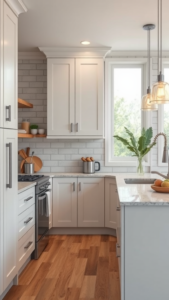Essential Design Tips for a Successful Home Remodeling Kitchen Project
Embarking on a home remodeling kitchen project can be both exhilarating and daunting. With careful planning and thoughtful design, you can transform your kitchen into a space that is not only functional but also aesthetically pleasing. Here are essential tips that will guide you towards a successful kitchen remodel.
Understand Your Needs and Goals
Before diving into any design decisions, take time to reflect on your lifestyle and needs. Consider the following:
- How do you use your kitchen? Do you often entertain guests, or is it primarily for family meals?
- What features are essential? Do you need more storage, updated appliances, or new countertops?
- What is your budget? Knowing how much you’re willing to spend will shape your choices and help avoid overspending.
Maximize Space and Layout
In any home remodeling kitchen project, layout is key. The most efficient kitchens follow the “work triangle” concept, which positions the sink, stove, and refrigerator in a triangular layout. This design minimizes walking distance between these key areas, enhancing your cooking experience. Here are some tips:
- Assess current space: Identify what works in your existing layout and what doesn’t.
- Consider an open floor plan: If you enjoy socializing while cooking, an open plan may connect your kitchen to dining or living spaces effectively.
- Utilize vertical space: Incorporate tall cabinets or wall-mounted shelves for extra storage without consuming floor space.
Select the Right Materials
Choosing quality materials not only enhances the kitchen’s durability but impacts its overall appearance. Consider materials that can withstand everyday wear and tear:
- Counters: Opt for materials such as quartz or granite for their durability and elegance.
- Cabinets: Solid wood cabinets are a great investment; they offer longevity and can be refinished whenever styles change.
- Flooring: Choose resilient flooring like ceramic tiles or luxury vinyl that combines beauty with functionality.
Focus on Lighting
A well-lit kitchen is vital for both functionality and mood. Layering light sources can greatly elevate the ambiance. Here are some ideas:
- Natural Light: Maximize windows or consider adding skylights to bring in daylight.
- Task Lighting: Under-cabinet lights help to illuminate work surfaces where food preparation takes place.
- Ambient Lighting: Pendant lights over an island or attractive chandeliers can serve as focal points while providing warmth to the space.
Add Personal Touches
Your kitchen should reflect your personality. Include design elements that bring you joy:
- Color Scheme: Don’t shy away from bold colors or patterns; they can create a lively atmosphere.
- Decorative Features: Open shelving can display unique dishware or your favorite cookbooks.
- Artwork: Adding art can offer a sense of completeness and make your kitchen feel inviting.
Plan for Sustainability
As you remodel your kitchen, consider efficient appliances and sustainable materials that are kind to the environment. Some eco-friendly options include:
- Energy-efficient appliances: Investing in Energy Star rated models can reduce your energy bills.
- Sustainable materials: Bamboo or reclaimed wood can add character and help minimize your carbon footprint.
- Smart technology: Incorporate smart home devices to monitor energy usage and control appliances remotely.
By employing these essential design tips, you can ensure that your home remodeling kitchen project turns out to be a functional, beautiful, and enjoyable cooking space. Keep your personal style in mind and plan thoughtfully, ensuring your remodel meets your needs while enhancing your home’s value.
Maximizing Space and Functionality in Your Kitchen Remodel
When considering a kitchen remodel, the goals often include enhancing both space and functionality. A well-designed kitchen can significantly improve your cooking experience and elevate the overall look of your home. Here are some strategies to maximize these vital aspects in your kitchen transformation.
Assess Your Current Space
Before diving into a remodel, it’s crucial to analyze your existing kitchen layout. Identify the areas that feel cramped or inefficient. Take note of:
- Workflow: Evaluate how you move around the kitchen. Is it easy to access cooking stations? Are your refrigerator, sink, and stove in convenient proximity?
- Storage: Look for spots that seem cluttered. Are there enough cabinets and drawers? Consider whether vertical space is being utilized properly.
- Lighting: Observe how well-lit your kitchen is. Poor lighting can make even the most functional kitchen feel small.
Open Up the Layout
One effective way to maximize space is by opting for an open-concept layout. This design approach allows for:
- Enhanced Flow: Reducing barriers between your kitchen and adjacent living areas can create a more inviting atmosphere.
- Increased Light: An open layout allows natural light to flow through, making the kitchen feel more spacious.
- Multi-functionality: Increased flexibility can turn your kitchen into a social hub, perfect for cooking and entertaining.
Smart Storage Solutions
When space is at a premium, innovative storage solutions become vital. Consider the following strategies:
- Vertical Cabinets: Tall cabinets draw the eye upwards and maximize vertical space.
- Pull-Out Shelves: These are perfect for optimizing deep cabinets, helping you access items easily.
- Floating Shelves: Not only do they provide extra storage, but they also add a contemporary flair to your kitchen.
- Turntables and Organizers: These help you make the most of corner cabinets and prevent clutter.
Functional Layout Designs
Consider incorporating popular layout designs that enhance functionality:
- U-Shaped Layout: This allows for efficient workflow with ample counter space without losing roominess.
- L-Shaped Layout: Perfect for small kitchens, this design keeps everything within reach while maximizing floor space.
- Galley Kitchen: This design works well in narrower spaces and enables easy access to appliances and workspace.
Thoughtful Appliance Placement
Placing your appliances thoughtfully can significantly impact the kitchen’s usability. A few tips to consider are:
- Designate Zones: Identify cooking, prep, and cleaning zones and arrange appliances accordingly.
- Keep Essentials Handy: Place everyday items like the toaster or microwave within reach to streamline cooking and cleaning.
- Space- Saving Appliances: Opt for smaller, multi-functional appliances that fit your kitchen better.
Surface Materials and Colors
The materials and colors you choose can greatly influence the perception of space in your kitchen. Here’s how to make smart selections:
- Light Colors: Bright colors can open up space, creating a welcoming environment.
- Reflective Surfaces: Glossy finishes on cabinets, backsplashes, and countertops can enhance light flow.
- Consistent Flooring: Use the same floor material throughout the kitchen and adjoining areas to create a seamless look.
Optimize Counter Space
Counter space is often limited in kitchens. Here are some creative solutions:
- Customizable Islands: An island that can double as a prep space and dining area adds valuable surface area.
- Integrated Appliances: Consider built-ins that free up counter space while maintaining functionality.
- Overhangs: Install countertop overhangs for quick meals and gatherings without needing a separate table.
By integrating these strategic elements into your kitchen remodel, you can create a space that is not only beautiful but also functional. Prioritize maximizing space and usability to enhance your daily cooking experience, making your remodel truly rewarding. With careful planning and design, your dream kitchen can become a reality, catering to your needs while staying stylish.
Conclusion
Transforming your kitchen through remodeling is an exciting journey that opens up a world of design possibilities. By implementing essential design tips, you not only enhance the aesthetic appeal of your space but also create a functional kitchen that meets your family’s needs. Choosing the right layout, selecting colors wisely, and incorporating practical storage solutions play pivotal roles in this transformation.
Maximizing space and functionality is crucial, especially in kitchens where every inch counts. Consider open shelving for easy access and natural light, or an island that serves as both a cooking area and a social hub. These elements can turn your kitchen into a dynamic environment that encourages cooking while fostering connections with family and friends.
Remember, a successful kitchen remodel is about blending style with practicality. Keep your personal tastes in mind and ensure that the design reflects your lifestyle. The joy of cooking and entertaining can be greatly enhanced in a well-thought-out kitchen space.
Whether you’re planning to undertake a full remodel or just looking for ways to update your kitchen, the right approach will lead to a rewarding outcome. With careful planning and creative thinking, your dream kitchen can become a reality, bringing both beauty and functionality to the heart of your home. Embrace the process, explore design inspirations, and look forward to a kitchen that will serve you well for years to come.




